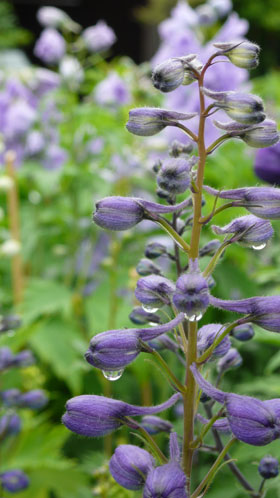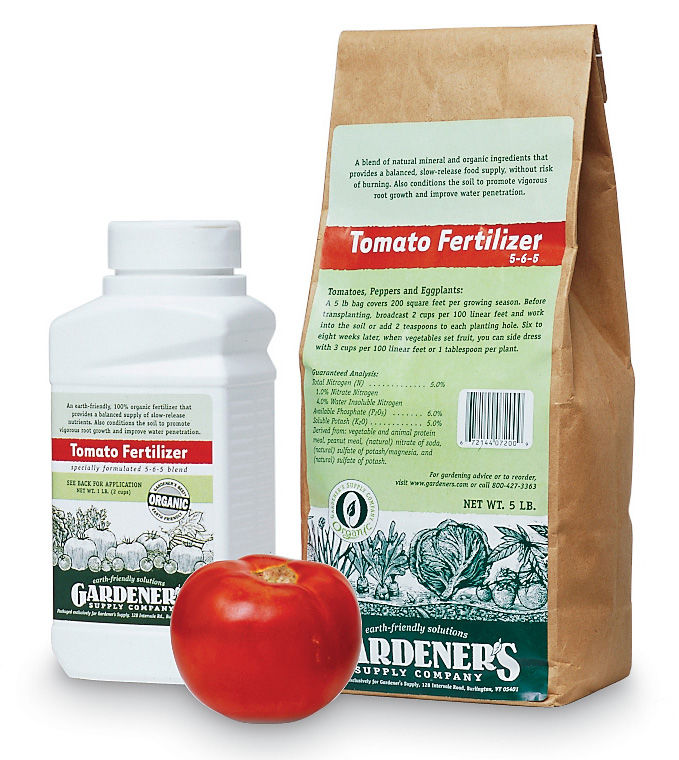





As a founding employee of Gardener's Supply, I wore many different hats over the years. Currently, I have my own company called Johnnie Brook Creative. The gardens around my home in Richmond, VT, include a large vegetable garden, seasonal greenhouse, cutting garden, perennial gardens, rock garden, shade garden, berry plantings, lots of container plants and a meadow garden. There's no place I'd rather be than in the garden.
ACCORDING to the Gallup Gardening Survey, less than half of the country's home gardeners use any kind of fertilizer on their lawns or gardens. What's unfortunate about this statistic is that it means gardeners aren't getting as many flowers or as much produce as they should. And they're probably struggling with disease and insect problems that could be avoided.

To look their best, most perennials require regular fertilization.
Well-fed plants are healthier, more productive and more beautiful. This article covers the basics of why and how to fertilize your garden.
Plants need to be fertilized because most soil does not provide the essential nutrients required for optimum growth. Even if you are lucky enough to start with great garden soil, as your plants grow, they absorb nutrients and leave the soil less fertile. Remember those tasty tomatoes and beautiful roses you grew last year? It took nutrients from the soil to build those plant tissues. By fertilizing your garden, you replenish lost nutrients and ensure that this year's plants have the food they need to flourish.
There are six primary nutrients that plants require. Plants get the first three—carbon, hydrogen and oxygen—from air and water. The other three are nitrogen, phosphorus and potassium.
Nitrogen helps plants make the proteins they need to produce new tissues. In nature, nitrogen is often in short supply so plants have evolved to take up as much nitrogen as possible, even if it means not taking up other necessary elements. If too much nitrogen is available, the plant may grow abundant foliage but not produce fruit or flowers. Growth may actually be stunted because the plant isn't absorbing enough of the other elements it needs.
Phosphorus stimulates root growth, helps the plant set buds and flowers, improves vitality and increases seed size. It does this by helping transfer energy from one part of the plant to another. To absorb phosphorus, most plants require a soil pH of 6.5 to 6.8. Organic matter and the activity of soil organisms also increase the availability of phosphorus.
Potassium improves overall vigor of the plant. It helps the plants make carbohydrates and provides disease resistance. It also helps regulate metabolic activities.
There are three additional nutrients that plants need, but in much smaller amounts:
Calcium is used by plants in cell membranes, at their growing points and to neutralize toxic materials. In addition, calcium improves soil structure and helps bind organic and inorganic particles together.
Magnesium is the only metallic component of chlorophyll. Without it, plants can't process sunlight.
Sulfur is a component of many proteins.
Finally, there are eight elements that plants need in tiny amounts. These are called micronutrients and include boron, copper and iron. Healthy soil that is high in organic matter usually contains adequate amounts of each of these micronutrients.
Do plants really care where they get their nutrients? Yes, because organic and synthetic fertilizers provide nutrients in different ways. Organic fertilizers are made from naturally occurring mineral deposits and organic material, such as bone or plant meal or composted manure. Synthetic fertilizers are made by chemically processing raw materials.
In general, the nutrients in organic fertilizers are not water-soluble and are released to the plants slowly over a period of months or even years. For this reason, organic fertilizers are best applied in the fall so the nutrients will be available in the spring. These organic fertilizers stimulate beneficial soil microorganisms and improve the structure of the soil. Soil microbes play an important role in converting organic fertilizers into soluble nutrients that can be absorbed by your plants. In most cases, organic fertilizers and compost will provide all the secondary and micronutrients your plants need.
Synthetic fertilizers are water-soluble and can be taken up by the plant almost immediately. In fact applying too much synthetic fertilizer can "burn" foliage and damage your plants. Synthetic fertilizers give plants a quick boost but do little to improve soil texture, stimulate soil life, or improve your soil's long-term fertility. Because synthetic fertilizers are highly water-soluble, they can also leach out into streams and ponds. Synthetic fertilizers do have some advantages in early spring. Because they are water-soluble, they are available to plants even when the soil is still cold and soil microbes are inactive. For this reason, some organically-based fertilizers, such as PHC All-Purpose Fertilizer, also contain small amounts of synthetic fertilizers to ensure the availability of nutrients.
For the long-term health of your garden, feeding your plants by building the soil with organic fertilizers and compost is best. This will give you soil that is rich in organic matter and teeming with microbial life.
Plants can absorb nutrients eight to 20 times more efficiently through their leaf surfaces than through their roots. As a result, spraying foliage with liquid nutrients can produce remarkable yields. For best results, spray plants during their critical growth stages such as transplanting time, blooming time and just after fruit sets.
Even if proper nutrients are present in the soil, some nutrients cannot be absorbed by plants if the soil pH is too high or too low. For most plants, soil pH should be between 6.0 and 7.0. A soil test will measure the pH of your soil. You can send a sample to a lab (contact your local extension service for a low-cost kit) or buy a home kit and do it yourself. Lime or wood ash can be used to raise pH; sulfur or aluminum sulfate can lower pH. Keep in mind that it's best to raise or lower soil pH slowly over the course of a year or two. Dramatic adjustments can result in the opposite extreme, which may be worse than what you started with. Once again, a helpful solution is to apply compost. Compost moderates soil pH and is one of the best ways to maintain the 6.5 ideal.

Our slow-release, granular GSC Organic Tomato Fertilizer (5-6-5) gives your tomatoes all the nutrients they need, including plenty of phosphorus for big, abundant fruit. For a healthy start, mix a handful into the soil at transplant time and then side dress when tomatoes begin to set fruit. Also ideal for peppers and eggplant.
In most cases, an all-purpose, 5-5-5 fertilizer will provide the nutrients all plants need for healthy growth. If a soil test reveals certain nutrient deficiencies, or if you want to tailor your fertilizer to the needs of particular plants (tomatoes vs. flowers), you can select a special formulation. What you choose will depend on your soil and what you are growing.
The three numbers that you see on a fertilizer label, such as 5-5-5, tell you what proportion of each macronutrient the fertilizer contains. The first number is always nitrogen (N), the second is phosphorus (P) and the third is potassium (K). This "N-P-K" ratio reflects the available nutrients —by weight—contained in that fertilizer. For example, if a 100-pound bag of fertilizer has an N-P-K ratio of 5-7-4, it contains 5 pounds of nitrate, 7 pounds of phosphate (which contains phosphorus), 4 pounds of potash (which contains potassium) and 84 pounds of filler.
Note that the N-P-K ratio of organic fertilizers is typically lower than that of a synthetic fertilizer. This is because by law, the ratio can only express nutrients that are immediately available. Most organic fertilizers contain slow-release nutrients that will become available over time. They also contain many trace elements that might not be supplied by synthetic fertilizers.
Fertilizers offered by Gardener's Supply are either all-organic, or contain primarily organic materials. To build the long-term health and fertility of your soil, we recommend using granular organic fertilizers. Supplementing with a water-soluble fertilizer ensures that your plants have the nutrients they need when they're in active growth
Copyright © www.100flowers.win Botanic Garden All Rights Reserved